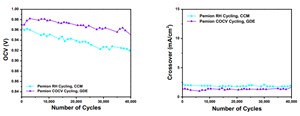News
Ionomr Innovations’ Pemion hydrocarbon-based proton exchange membrane exceed industry durability targets
Ionomr Innovations' Pemion has achieved performance and durability testing results that surpass internationally recognized standards from the U.S. Department of Energy (DOE) and Hydrogen Europe, confirming the company’s proprietary hydrocarbon-based proton exchange membrane and polymer is ready for widespread heavy-duty fuel cell applications.
The Pemion membrane was tested for and met established accelerated durability benchmarks for combined chemical and mechanical stress testing. Throughout 1,000 hours of cyclical testing that exposed the membrane to intermittent dry and wet conditions under high-voltage chemical stress, Pemion exceeded the internationally recognized 20,000 cycle durability targets set by the DOE for polymer electrolyte membranes by more than two-fold.
As far as the company is aware, Pemion is the first hydrocarbon-based membrane to ever pass these tests. Pemion is used in fuel cell applications including heavy-duty transport, automotive, and stationary power. The materials have been designed to provide superior chemical, thermal, and mechanical stability, high conductivity, operational durability, and efficiency, all of which dramatically reduce the unit cost of the fuel cell.
- PemionÒ materials’ gains in performance and reductions in gas crossover result in a significant reduction in lifetime H2 fuel cell cost.
- Alongside improved fuel efficiency, the lifetime of the fuel cell is enhanced due to reduced degradation.
- Higher operating temperatures are possible for higher power stacks with improved cooling and heat rejection.
- PemionÒ boasts one of the highest room temperature proton conductivities available under a variety of conditions, while maintaining its mechanical stability, allowing implementation in diverse systems from light to heavy-duty, and beyond.
“This testing confirms Pemion as a differentiator for fuel cell manufacturers looking to overcome the challenges of a tight supply market for conventional polymer and membrane materials, without any trade-offs to lifetime or performance,” said Ionomr CEO, Bill Haberlin. “Fluorinated materials such as those currently used in fuel cells are good at what they do, but they require toxic and highly regulated chemicals to be produced. As regulations continue to tighten, fuel cell and stack manufacturers will need to find practical material replacements. Pemion’s performance and durability record and environmentally benign hydrocarbon-base create a step-change alternative.”
Performance testing on the Pemion membrane and polymer included the DOE, COCV protocol – a combined chemical and mechanical stability accelerated stress test designed for fuel cell membranes – as well as the DOE RH cycling mechanical durability protocol. The tests, which were run for over 40,000 cycles with electrochemical assessments every 24 hours, demonstrated exceptional stability of the membrane in various membrane electrode assembly (MEA) configurations. Critically, MEAs containing Pemion membranes exhibited minimal decreases in open circuit voltage (OCV) throughout the lifetime of the test, alongside exceptionally low and stable gas crossover.
These durability tests on Pemion membranes show the material is fully capable of achieving and exceeding the DOE’s 20,000 cycle target for fuel cell membranes – a target established to screen for viable materials to meet the ultimate goal of a heavy-duty fuel cell vehicle capable of operating for a million miles.
The tests were run for a minimum of 40,000 cycles following the DOE’s Fuel Cell Technologies Office Multi-Year Research, Development, and Demonstration Plan. Electrochemical diagnostics were performed every 24 hr. As outlined in Table P.5 of the Fuel Cells section of this plan, the COCV protocol seeks to examine combined the effects of chemical and mechanical stressors on the membrane, within an operating fuel cell. This is accomplished by cycling the MEA from 0% RH (30s) to 90°C dew point (45 s) at 90 °C cell temperature continually, until the membrane fails because of high gas crossover (leaking) or meets the 20,000-cycle target.
RH cycling mechanical stress tests were performed following the protocol outlined in Table P.5, except without the continuous OCV hold. Hence, the MEAs were cycled from 0% RH (30 s) to 90°C dew point (45 s) at 90 °C cell temperature continually. This is an important comparison to the COCV protocol because historically, hydrocarbon-based materials either fail due to chemical instabilities, or mechanical stressors because of swelling and deswelling during operation. Comparing the results of these two tests better highlights the capabilities of a given material.
MEAs were tested using both catalysts coated membrane (CCM) and gas diffusion electrode (GDE) configurations. The CCMs were fabricated internally using Ionomr’s Pemion membrane with common fuel cell catalysts and ionomers. For MEAs tested using a GDE configuration, Pemion membranes were used as-is and sandwiched between two commercially-available GDEs containing common fuel cell catalysts and ionomers.


